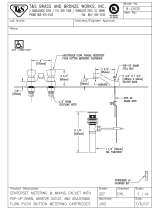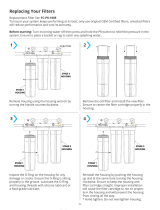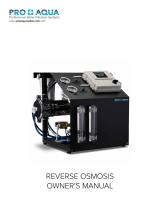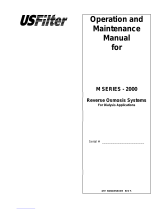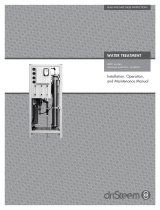
7
Introduction
The CI-1000 Reverse Osmosis Controller is designed to control and
monitor the operating parameters of a reverse osmosis water puri-
fication system. Information is displayed on a back-lit liquid crystal
display, and on individual light-emitting diodes (LEDs). Functions and
controls are operated through snap-dome switches (see Figure 2).
Features
Temperature Compensated Conductivity Monitor
Water Temperature Monitor
Three Modes of Operation: Stand-by, Tank Feed, and Direct Feed
Pretreatment Interlock
Tank Full Shutdown
Inlet Valve Control
Pump Control
Low Feed Pressure Sensing with Automatic Reset
Autoflush with Adjustable Flush Time
Diverter Valve Output
Specifications
Power Requirements: The controller can operate with a power
source of 115 or 230 VAC single phase. A multi-function power inlet
is used to select the proper input voltage.
Fuse: 1 amp 250 volt slow blow, located inside the power inlet
receptacle.
Environment: The controller can operate at a temperature from 0° to
60°C (32° to 140°F). Relative humidity must not exceed 95 percent.
Conductivity Monitor: The conductivity monitor measures the prod-
uct water quality and displays this information in micro-mhos/cm.
The display is temperature compensated to 25°C (770°F).
Outputs
Inlet Solenoid: A 24 VAC output is provided to power the inlet
solenoid. This output always energizes 12 seconds before the pump
turns on, and de-energizes 12 seconds after the pump turns off.
Flush Valve: A 24 VAC output is provided to power the optional
reject solenoid valve. This output will energize during the flush cycle.
This is an optional accessory.
Motor Starter: A 24 VAC output is included to provide controlled
pump operation. This output powers the coil of the magnetic starter
relay. This output is energized depending on other operating param-
eters.
Auxiliary Output: A 24 VAC output that energizes under certain con-
ditions, depending upon the mode selected for it in the configuration.
This output is intended to power a relay or some other low current
device. The maximum current available is one ampere. Two modes
are selectable for this output:
Diverter: Output energizes when the product quality is below
the set point. The diverter valve is not included with the system.
Alarm: Output energizes for final detection of low-pressure
conditions and low water quality conditions. No alarm hardware
is included with the system.
Inputs
WARNING: All the inputs described below are dry contacts.
Do not apply voltage to these contacts or permanent damage
to the controller will result.
Conductivity Probe: There are four inputs for the conductivity
probe, two for the thermistor and two for the conductivity. Only
probes with a cell constant of 1.0 and a thermistor with a nominal
resistance value of 20K at 25' C will work with this controller.
Low-pressure Switch: This is a dry contact that signals the system
to shut down if the pump suction pressure falls below the desired
value. This is a normally open contact. When a circuit is not com-
plete between the two terminals, the system will operate. If contact
is made between the two terminals, the system will shut down. The
LCD display and a LED will indicate when the system is shut down
due to low-pressure. The controller can be programmed to automati-
cally restart. This is described in Section III, Operation.
Tank Level: This is a dry contact that signals the system to shut
down when the storage tank is full. This contact is normally closed.
When a circuit is complete between the two terminals the system will
operate. If contact is broken between the two terminals, the system
will shut down if it is operating in the tank feed mode. A LED will
indicate when the tank is full. The system will restart itself when the
contact is closed. The switch for this function in not provided with
the controller.
Pretreatment Interlock: This is a dry contact that signals the system
to shut down when a pretreatment device is not functioning, or re-
generating. This could be used on a water softener, multi media filter,
chemical feed pump, differential pressure switch, etc. This contact is
normally open. When a circuit is not complete between the two ter-
minals the system will operate. If the contact is= closed the system
will shut down. A LED will indicate when the system is shut down
due to pretreatment interlock. The system will restart itself when the
contact is opened.
Mode Descriptions
The stand-by mode is intended to place the system in a temporary
non-operational mode. When the system is placed in this mode it
will operate for the amount of time set for the flush cycle. If the flush
time is set for zero the system will operate for one minute. After this
cycle is complete the pump will turn off and the inlet valve will close.
The system will repeat this cycle once every hour. When the system
is flushing, the amount of time remaining in the flush cycle will be
indicated on the last line of the display. When the system is idle, the
amount of time remaining until the next flush will be indicated. When
the pump is running, the reject valve and diverter valve outputs are
energized.
The tank feed mode is intended to be used when the system is
feeding a storage tank. When in this mode the system will shut down
when the tank level switch (not provided) has an open contact. The
flush cycle is also enabled in this mode. If the autoflush option has
been included on the system, the controller will activate the flush
cycle when the system is turned on and once every hour. When the
system is flushing, the amount of time remaining in the flush cycle will
be indicated on the last line of the display. When the system is not
flushing the amount of time until the next flush will be indicated. The
system will still flush every hour even if the tank is full. During a full
tank condition the system is essentially in standby. When the system
is flushing, the diverter valve output is energized. If the flush time is
set for zero the system will not flush when the tank is full.
The direct feed mode is intended to be used when the system is
feeding a distribution loop or another piece of equipment. In this
mode the system will not flush and the tank level switch is disre-
garded. When the system is in this mode, the total number of hours
the system has been operated will be indicated on the last line of the
display.
Reverse Osmosis Controller
Operations and Maintenance Model #CI-1000
















